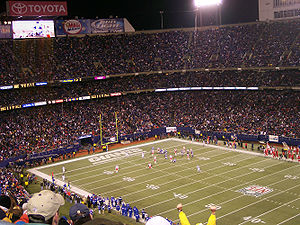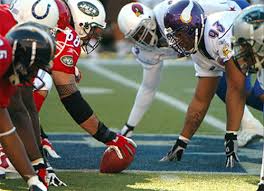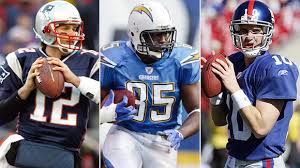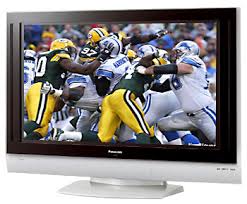 |
Watch live streaming nfl tv
 Watch live streaming nfl tv
Watch live streaming nfl tvNFL
United States
The National Football league called NFL.
New York Giants vs Kansas City Chiefs
Match scheduled:
Last updated: 04-10-2009 from 17:00 until 20:30
02-10-2009 on 10:36
Week 4 :: NFL Regular Season 2009/2010

 |
The Giants played their first game against All New Britain in New Britain, Connecticut, on October 4, 1925.[2][3] They defeated New Britain 26–0 in front of a crowd of 10,000.[2] The Giants were successful in their first season, finishing with an 8–4 record in 1925.[4

 |
In just its third season, the team finished with the best record in the league at 11–1–1 and was awarded the NFL title.[5] After a disappointing fourth season (1928) owner Mara bought the entire squad of the Detroit Wolverines, principally to acquire star quarterback Benny Friedman, and merged the two teams under the Giants name.

 |
In 1930, there were still many who questioned the quality of the professional game, claiming the college "amateurs" played with more intensity. In December 1930, the Giants played a team of Notre Dame All Stars at the Polo Grounds to raise money for the unemployed of New York City. It was also an opportunity to establish the superiority of the pro game. Knute Rockne reassembled his Four Horsemen along with the stars of his 1924 Championship squad and told them to score early, then defend. Rockne, like much of the public, thought little of pro football and expected an easy win.[6] But from the beginning it was a one-way contest, with Friedman running for two Giant touchdowns and Hap Moran passing for another. Notre Dame failed to score. When it was all over, Coach Rockne told his team, "That was the greatest football machine I ever saw. I am glad none of you got hurt."[7] The game raised $100,000 for the homeless, and is often credited with establishing the legitimacy of the professional game.[6]

 |
[edit] 1933–46
In a fourteen-year span from 1933 to 1946, the Giants qualified to play in the NFL championship game 8 times, winning twice.[5] During the period the Giants were led by Hall of Fame coach Steve Owen, and Hall of Fame players Mel Hein, Red Badgro, and Tuffy Leemans. This period also included the famous "Sneakers Game", where they defeated the Chicago Bears on an icy field in the 1934 NFL Championship game, while wearing sneakers for better traction.[5] The Giants were particularly successful from the latter half of the 1930s until the United States entry into World War II. They added their third NFL championship in 1938 with a 23–17 win over the Green Bay Packers.[5]

 |
[edit] 1947–63
They did not win another league title until 1956, aided by a number of future Pro Football Hall of Fame players such as running back Frank Gifford, linebacker Sam Huff, and offensive tackle Roosevelt Brown, as well as all-pro running back Alex Webster. The Giants' 1956 championship team not only included players who would eventually find their way to the Pro Football Hall of Fame, but it also had a Hall of Fame coaching staff. Head coach Jim Lee Howell's staff had Vince Lombardi coaching the offense and Tom Landry coaching the defense.[8] From 1958 to 1963, the Giants played in the NFL Championship Game five times, but failed to win.[5] Most significantly, the Giants played the Colts in the 1958 NFL Championship Game that is considered a watershed event in the history of the NFL.[9] The game, which the Giants lost in overtime 23–17,[5] is often considered one of the most important events in furthering the NFL's popularity in America. The following year, they gave up a 16–9 4th quarter lead to again lose to the Colts in the championship game, 31–16. In 1963 led by league MVP quarterback Y.A. Tittle, who threw an NFL record 36 touchdown passes, the Giants advanced to the NFL Championship Game, where they lost to the Bears 14–10.

 |
[edit] 1964–78
From 1964 to 1978, the Giants registered only two winning seasons and were unable to advance to the playoffs.[4] With players such as Tittle and Gifford approaching their mid 30s, the team declined rapidly, finishing 2–10–2 in 1964.[4] They rebounded with a 7–7 record in 1965,[4] before compiling a league-worst 1–12–1 record,[10] and allowing more than 500 points on defense in 1966.[10] During the 1969 preseason, the Giants lost their first meeting with the Jets, 37–14, in front of 70,874 fans at the Yale Bowl in New Haven, Connecticut.[11] Following the game, Wellington Mara fired coach Allie Sherman,[12] and replaced him with former Giants fullback Alex Webster.

 |
In 1967, the team acquired quarterback Fran Tarkenton from the Minnesota Vikings. Despite having several respectable seasons with Tarkenton at quarterback, including a 7–7 finish in 1967 and 9–5 in 1970,[4] the Giants traded him back to the Vikings after the 1971 season when the Giants went 4–10.[13] Tarkenton would go on to lead his team to three Super Bowls and create a Hall of Fame resume,[13] while the Giants suffered through one of the worst stretches in their history.[4] Starting in 1973 the Giants compiled only 23 wins in 6 seasons.[4] Before the 1976 season, the Giants tried to replace retired RB Ron Johnson with future HOF fullback Larry Csonka to revive a weak offense. Csonka was unfortunately often injured and ineffective during his 3 years in New York. The 1977 season also featured the unusual choice of having three rookie quarterbacks on their roster.[

 |
During this period, due to the renovation of Yankee Stadium, which the team shared with baseball's New York Yankees, the Giants were forced to play their home games at the Yale Bowl from 1973 through 1974, and Shea Stadium in Queens, NY in 1975.[8] They finally received their own dedicated state-of-the-art stadium in 1976,[8] when they moved into Giants Stadium at the Meadowlands in East Rutherford, New Jersey. One of the low points during this period was the so-called "Miracle at the Meadowlands," which occurred in 1978.[15] With the Giants needing only to kneel the ball to secure a certain victory against the Philadelphia Eagles,[15] they chose to call a running play—which resulted in a fumble that was returned for a game-winning touchdown by the Eagles' Herman Edwards.[15]

 |
[edit] 1979–93

In 1979, the Giants began the steps that would, in time, return them to the pinnacle of the NFL. These included the drafting of quarterback Phil Simms in 1979, and linebacker Lawrence Taylor in 1981.[8] In 1981, Taylor won the NFL's Defensive Rookie of the Year and Defensive Player of the Year awards and the Giants made the playoffs for the first time since 1963.[4][16] One of the few bright spots during this time was the team's excellent linebackers, who were known as the Crunch Bunch.[17] After the strike-shortened the 1982 season, in which they finished 4–5,[4] head coach Ray Perkins resigned to take over the same position at the University of Alabama. In a change that would prove crucial in the coming years, he was replaced by the team's defensive coordinator, Bill Parcells.

 |
[edit] Parcells era
The Giants struggled in Parcells's initial year and finished with 3–12–1 record.[4] After 9–7 and 10–6 finishes in 1984 and 1985 respectively,[4] the Giants compiled a 14–2 record in 1986 led by league MVP and Defensive Player of the Year Taylor. After defeating the 49ers and Redskins by a combined score of 66–3 in the playoffs, the Giants advanced for the first time to play the Denver Broncos at the Rose Bowl in Pasadena in Super Bowl XXI. Led by Super Bowl MVP Simms who completed 22 of 25 passes for a Super Bowl record 88% completion percentage, they defeated the Broncos 39–20,[18] to win their first championship since 1956. In addition to Simms and Taylor, the team was led during this period by head coach Bill Parcells, tight end Mark Bavaro, running back Joe Morris, and Hall of Fame linebacker Harry Carson.

 |
The Giants struggled to a 6–9 record in the strike-marred 1987 season,[4] with the running game in particular struggling. After rushing for 1,526 and 1,336 yards in 1985 and 1986 Morris struggled to 658 yards[19] behind an injury-riddled offensive line in 1987.[20] The early portion of the 1988 season was marred by a scandal involving Lawrence Taylor. Taylor had abused cocaine and was suspended for the first four games of the season for his second violation of the league's substance abuse policy. Despite the controversy, the Giants finished 10–6, and Taylor recorded 15.5 sacks after his return from the suspension. They surged to a 12–4 record in 1989, but lost to the Los Angeles Rams in their opening playoff game when Flipper Anderson caught a 47-yard touchdown pass to give the Rams a 19–13 overtime win. In 1990, the Giants went 13–3, and set an NFL record for fewest turnovers in a season (14),[21] and defeated the Buffalo Bills in Super Bowl XXV.[18]

 |
[edit] 1991–93
Following the 1990 season, Parcells resigned as head coach and was replaced by the team's offensive coordinator Ray Handley. Handley served as coach for two disappointing seasons (1991–92), which saw the Giants fall from Super Bowl champions to a 6–10 record. He was fired following the 1992 season, and replaced by former Denver Broncos' coach Dan Reeves. In the early 1990s, Simms and Taylor, two of the teams' largest figures in the 1980s, played out the last seasons of their career with steadily declining production. The Giants experienced a resurgent season with Reeves at the helm in 1993 however, and Simms and Taylor ended their careers as members of a playoff team

 |
[edit] 1994–98
The Giants initially struggled in the post Simms-Taylor era. After starting 3–7 in 1994, the Giants won their final six games to finish 9–7 but missed the playoffs.[22] Quarterback Dave Brown received heavy criticism throughout the season.[23] Brown performed poorly the following two seasons, and the Giants struggled to 5–11 and 6–10 records.[4] Reeves was fired following the 1996 season, and replaced by Jim Fassel, former offensive coordinator of the Arizona Cardinals. Fassel named Danny Kanell the team's starting quarterback, and the team finished 10–5–1 and made the playoffs in 1997.[4] After losing in the first round to the Vikings in 1997, the Giants needed four wins to close out the season to finish 8–8 in 1998.

 |
[edit] 1999
Before the 1999 season Kerry Collins was brought in to help the team. Collins was the first–ever draft choice of the expansion Carolina Panthers in 1995, and led the Panthers to the NFC Championship game in his second season. However, problems with alcohol, conflicts with his teammates and questions about his character led to his release from the Panthers.[24] The Giants finished 7–9 in 1999.[4]

 |
[edit] 2000
The 2000 season was considered a make-or-break year for Fassel. The conventional wisdom was that Fassel needed to have a strong year and a playoff appearance to save his job. After two back-to-back losses at home against St. Louis and Detroit, the Giants fell to 7–4[25] and their playoff prospects were in question. At a press conference following the Giants' loss to Detroit, Fassel guaranteed that "[t]his team is going to the playoffs."[26] The Giants responded, winning the rest of their regular season games to finish the season 12–4[25] and earn a bye as the NFC's top seed.

 |
The Giants won their first playoff game against the Philadelphia Eagles, 20–10, and defeated the Minnesota Vikings 41–0 in the NFC Championship game.[25] They advanced to play the Baltimore Ravens in Super Bowl XXXV. Though the Giants went into halftime down only 10–0,[27] the Ravens dominated the second half. Their defense harassed Kerry Collins all game long, resulting in Collins completing only 15 of 39 passes for 112 yards and 4 interceptions.[27] The Ravens won the game 34–7.[2

 |
[edit] 2001–06
The Giants struggled after their Super Bowl loss and Fassel was replaced by current coach Tom Coughlin in 2004. Although Collins had several solid seasons as the Giants quarterback, he experienced his share of struggles. In 2004, the Giants completed a draft day trade acquiring quarterback Eli Manning out of the University of Mississippi.[28] Manning has been the team's starting quarterback since the middle of the 2004 season, taking over for Kurt Warner. The early part of Coughlin's tenure also produced inconsistent results (a 25–23 record and two playoff appearances—both losses, before the 2007 season[29]) and spawned intense media scrutiny concerning the direction of the team.[30] During this period in their history, standout players include defensive end Michael Strahan, who set the NFL single season record in sacks in 2001,[31] and running back Tiki Barber, who set a team record for rushing yards in a season in 2005.[32]
[edit] 2007
Going into 2007, the Giants had made the playoffs in three consecutive seasons. In 2007, the Giants became the third NFL franchise to win at least 600 games when they defeated the Atlanta Falcons on Monday Night Football 31–10. For the 2007 season, the NFL scheduled the Giants' road game against the Miami Dolphins on October 28 to be played in London's Wembley Stadium; this was the NFL's first regular-season game to be played outside of North America. The Giants defeated the Dolphins, 13–10. The Giants finished 10–6, and became NFC Champions after defeating the Tampa Bay Buccaneers, Dallas Cowboys, and Green Bay Packers in the NFC Playoffs. They set the record for most consecutive road wins (which ended at 12 after losing to the Cleveland Browns during week 6 of the 2008 season).
[edit] Super Bowl XLII

 |
The Patriots (18–0) had entered the game 12.5-point favorites and went to Glendale, Arizona, undefeated. With a final score of 17–14, the Giants defeated the New England Patriots in Super Bowl XLII, in the third biggest upset by betting line in Super Bowl history. (Baltimore was favored by 17 over New York in Super Bowl III, and St. Louis was favored by 14 over New England in Super Bowl XXXVI; New England was favored by only 12.5 over New York.) [33] Co-owner John Mara described it as "the greatest victory in the history of this franchise, without question."[34

 |
The Super Bowl week started off with some trash talk. Plaxico Burress said the Giants were going to win by a score of 23-17. New England quarterback Tom Brady responded by chuckling and saying, "He thinks they are only going to hold us to 17 points?". This was some bulletin material for the Giants, and it fired up the defense.

 |
 |  |  |  |  |

 |
The victory was mainly in part to New York's final drive, in which on a 3rd-and-5 with the Giants trailing 14 to 10 with 1:15 left, Eli Manning escaped the grasps of several of the Patriot's linemen. He stood up and threw it downfield to little-known wide receiver David Tyree, who leaped up, pinned the ball against his helmet and was able to hold while being dragged down by a defender Rodney Harrison. It is now considered one of the greatest moments in Super Bowl history. Finally, Manning threw a touchdown pass to Plaxico Burress. New England had the ball on their own 26 yard line with 29 seconds left. Tom Brady threw an incompletion, got sacked, then threw two more incompletions. Eli Manning kneeled down to kill the final seconds of the game, making the victory official.

 |
[edit] 2008
In 2008, the Giants won the NFC East with a record of 12–4 (also was the number one seed in the NFC), losing to the Philadelphia Eagles in the divisional round of the playoffs.

 |
 |  |  |  |  |
[edit] Logos and uniforms
With over 80 years of team history, the Giants have used numerous uniforms and logos. Giants' logos include several incarnations of a giant quarterback preparing to throw a football, a lowercase "ny", and stylized versions of the team nickname.

 |
 Two of the Giants "Giant Quarterbacks" logos; primary logo 1956–60 (top), and secondary logo 2000-current.
Two of the Giants "Giant Quarterbacks" logos; primary logo 1956–60 (top), and secondary logo 2000-current. |  |  |  |  |

















